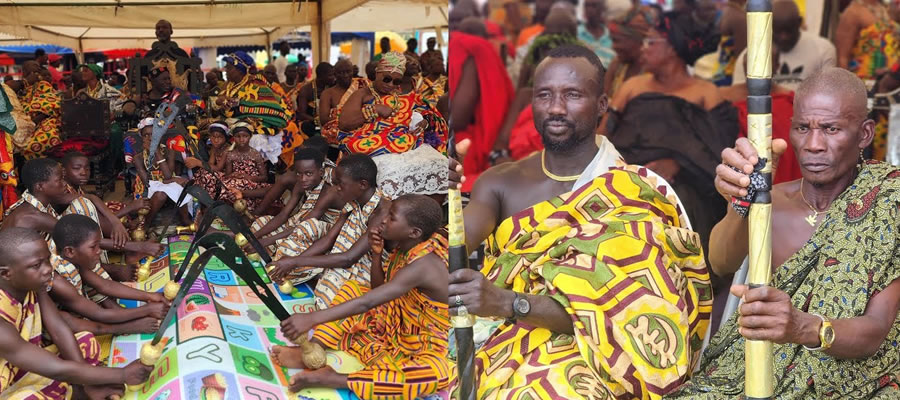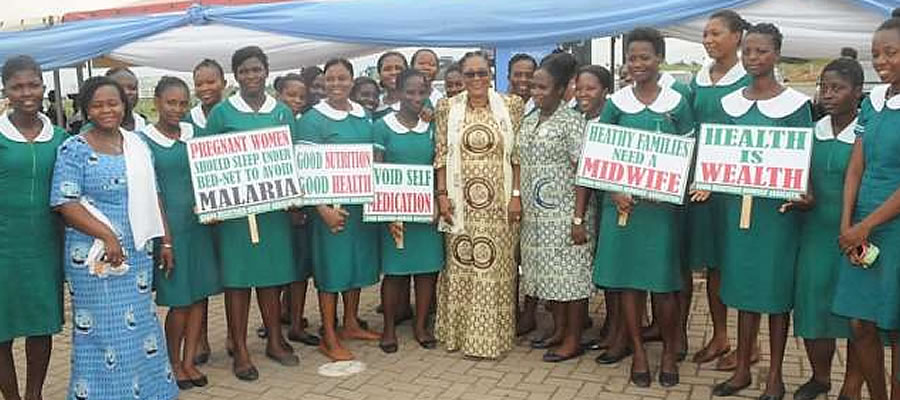

Water
The Ghana Water Company Limited (GWCL) supplies potable water for domestic, industrial, institutional and commercial purposes within the Metropolis. Also, the Community Water and Sanitation Agency (CWSA) provide boreholes to communities with lower populations within the Metropolis. The present water supply to the Twin City is from two headworks at Inchaban and Daboasi. The Daboasi Water Treatment Plant was designed to produce 6 million gallons per day (mgd), and the Inchaban Plant is designed to produce 4.6mgd. The two plants are presently producing 4.5mgd and 2mgd respectively due to inefficiencies in the plants. The low production at Daboasi is also due to the inability to take full advantage of the amount of raw water available, as the water intake has no impoundment facilities to increase the water available for treatment. The distribution systems from the two headworks are interconnected and water is boosted from the Inchaban pumping station to a low-level storage tank at Effia where the water is pumped into an overhead tank for distribution by gravity to the city.
The city has smaller booster stations to pump water to reservoirs situated at strategic points in the Metropolis for gravity distribution to the areas being fed with water from GWCL. The main water pipelines have been laid to presently serve more than 70% of the city. GWCL estimates that 160 km of additional pipelines are required to be able to reach the remaining areas of the city. The total daily production at the reduced design capacity of 6.5mgd is far below the presently estimated city demand of 22mgd and this explains the unsatisfactory state of the water supply to the city. This notwithstanding, as high as 90% of the Metropolis have access to potable water with the remaining 10% resorting to other means of water supply sources as uncovered wells.
The Takoradi sub metro has the highest in-house tap services, on the other hand, Essikado Ketan sub metro has the least record of in-house tap service, The plan period captures activities to ensure that in-house tap services are equally distributed across the metropolis.
Sources of Potable Water in the Metropolis
There are about 9 main sources of water for households within the Metropolis. Out of this total, six (6) are potable sources whiles the remaining three (3) are considered not potable sources. The potable sources include: In-house tap, in-yard tap, in the yard well (covered), public well (covered), borehole and public taps whereas the non-potable sources include in the yard well (not covered), surface water, and public well (not covered). In general, over 80 percent of households in the Metropolis have access to water via potable sources.
Sanitation and Waste Management
Sanitation and Waste Management is the sole responsibility of the Metropolitan Assembly. Presently four (4) waste management services are engaged to perform this major responsibility through the adoption of the polluter-pay principle. The solid waste generated amounts to 614 tons/day with collection at 360 tons/day. This results in 224,724 tons/year generation and 131,760tons/year collection respectively. The final disposal system is controlled tipping at the engineered landfill site for solid waste and an oxidation system for liquid waste disposal. The waste collection system being operated in the metropolis is a mix of door refuse collection systems and communal container lifting systems. Newly developed areas in the Metropolis are poorly served with services such as water, electricity, telecommunication and other ancillary services.
About 78% of households in Sekondi-Takoradi have undesirable access to toilet facilities. Among households in the Metropolis, only 17% have access to household water closet toilet facilities, while 49% use public toilet facilities. Desirable toilet facilities are water closets or Kumasi Ventilated Improved Pit latrines, located within the housing unit. Undesirable toilet facilities include a bucket/pan, a facility in another house, or a public toilet. About 78% of households residing in informal settlements within the Sekondi-Takoradi Metropolis have undesirable access to toilet facilities. There are 102 public toilets meant to serve commuters scattered in the Metropolis, but they have been turned into community toilets as many residents (over 80%) lack household toilet facilities, rely heavily on these public toilets. This has resulted in high incidences of open defecation in communities like New Takoradi, Nkotompo, Ngyiresia and Kojokrom.
Date Created : 2/6/2025 2:47:12 AM











 facebook
facebook
 twitter
twitter
 Youtube
Youtube
 +233 593 831 280
+233 593 831 280 0800 430 430
0800 430 430 GPS: GE-231-4383
GPS: GE-231-4383 info@ghanadistricts.com
info@ghanadistricts.com Box GP1044, Accra, Ghana
Box GP1044, Accra, Ghana